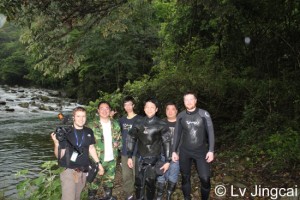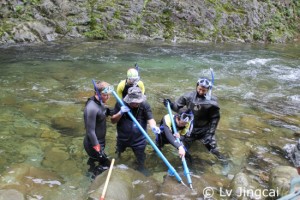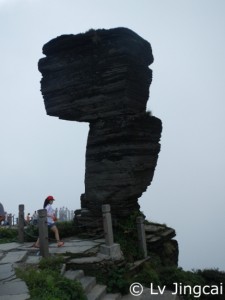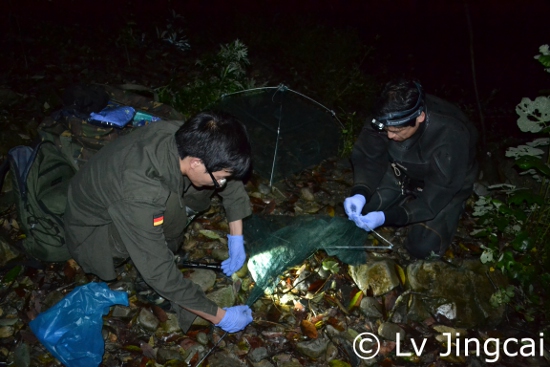
Guest Blog: EDGE Fellow Lv Jingcai talks about a recent workshop for the Chinese giant salamander held in China
The field survey workshop of a sustainable future for wild Chinese giant salamanders (CGS), held in Fanjingshan National Nature Reserve (FNNR), Guizhou province, China. From 6th to 15th of May 2013, the CGS field survey training that lasted for 10 day finished very quickly. When I think about this period of training, it has touched me deeply. I will share some of my thoughts with everyone.
FNNR (108°45′55″- 108°48′30″E, 27°49′50″- 28°01′30″N) was founded in 1987. It is located at a junction among Jiangkou, Songtao and Yinjiang counties, which is in the northeast of Guizhou province, China. The total size of FNNR is roughly 41 900 ha. Fanjingshan is the main peak of Wulin Mountain, which is a transitional zone from the Yunnan-Guizhou Plateau to Western Hunan hills. FNNR is situated in the center of the subtropical zone, possessing classical mid-subtropical monsoon mountainous humid climate. In addition, due to its special geographical location and advantageous hydrothermal conditions, FNNR is the habitats of much different wildlife. At present, 6 species have been considered as China’s State Key Protected Animal, such as Guizhou snub nosed monkeys (Rhinopithecus brelichi), which is as famous as giant pandas. In addition, 52 Category II species have been put on the list of China’s State Key Projected Wildlife, such as Tibetan macaques (Macaca thibetana), wild Chinese giant salamanders (Andrias davidianus) and Spur-leaf (Tetracentron sinensis) are distributed widely in FNNR.
The goals of this field survey workshop is to train EDGE Fellows and Staff from FNNR focusing on long-term surveying and monitoring of wild CGS in Guizhou. Strengthen in situ conservation of the wild CGS; develop standardised questionnaire-based survey protocols; develop standardised field survey protocols and develop long-term monitoring protocols and strategy.
Before training, professor Sumio Okada from Tottori University, introduced how to record morphometric measurements of CGS, including measuring the total length, snout-vent length, head width, tail height, weight, sex and so on. Jay Redbond from WWT, and Professor Okada introduced the field survey techniques, such as wading, turning substrate, netting, snorkeling, nocturnal spotlighting, crab traps, baited traps and so on. In addition, Benjamin Tapley from ZSL introduced how to use different water test kits, amphibian marking techniques and the use of PIT tags and the microchip reader and swabbing to collect genetic & disease samples (buccal-swabbed, skin-swabbed, cloacal-swabbing ).
After being trained in conducting questionnaire towards villagers and field survey techniques, we went into FNNR to conduct field survey to apply the field techniques from the third day. We went into FNNR to observe the habitats of CGS. Even though there had been heavy rainfall in the past few days and it was still pouring, we did not cower. After we put on wet suits and entered the river, we searched for a long time, but could not find any indications of wild CGS. During the night, we found some places in Panxi River where CGS possibly existed and laid down some traps.
In the next few days, we picked two rivers with good ecological conditions and conducted a longer term research. In the morning we checked the traps that were laid down in the previous night, and checked the water quality and CGS habitat characteristics. In the afternoons and evenings we searched for indications of wild CGS in the river. Everyday, we chose a 1 km stretch of the river, and searched for CGS using wading, turning substrate, and netting. Then we returned to the start point, and used nocturnal spotlighting and snorkeling to find CGS. Our field survey was very difficult and tiring, as we worked in the fields both day and night. As time was tight, we could not return back to our accommodation for meals and ate some snacks for dinner out in the field. During the survey period, we heard that a villager had seen CGS in the past month and that a few wild CGS were seen in a 5m deep water reservoir. We started searching at this particular site but still did not find any wild CGS.

Although the training period has been very short, it has been very successful. The field survey has been very enjoyable. During work time, we went to the fields together. During rest time, we helped each other and learnt from each other.
The research is not easy but it is very important work to conserve the species. In future field surveys, I will follow the standardised protocols strictly and investigate other sites in Guizhou province. I hope to use these cutting edge techniques in the investigation of wild CGS in Guizhou province. These will form the basis of investigating the status of wild CGS in Guizhou and enable an efficient long term investigation.

To find out more about the Chinese giant salamander project click here.
To find about more about EDGE fellow Lv Jingcai click here.

